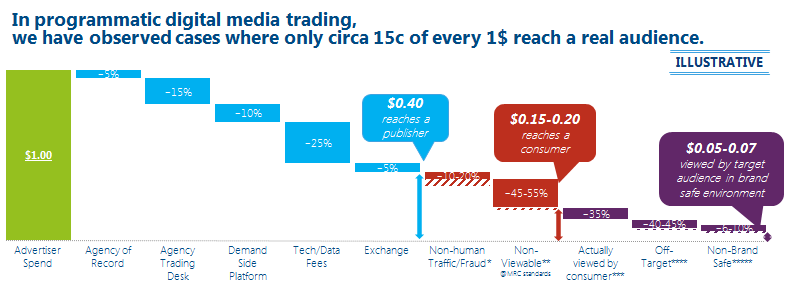Despite massive improvements over the past year for providing transparency in media, it is still a significant issue that companies are actively trying to fix. At the annual ProcureCon Marketing conference, held at the Marriott Hotel in the heart of New Orleans, the main buzzword of the year, transparency, was in full effect.
Since the ANA Media Transparency Initiative was published last year, the topic of transparency has never been bigger and it was clear based on the discussions at ProcureCon, that it still remains top of mind for most marketing and procurement professionals.
Attaining full media transparency
To help bring some clarity to this topic, Fiona Foy, Managing Director, North America of FirmDecisions, addressed this topic head-on during her panel on transparency in production. Specifically, this session helped attendees gain a further understanding of the relationship between marketing, procurement, and suppliers, pre-empting questions from executive leaders, and how to demonstrate action in the context with existing or longstanding agreements. Even something as simple as knowing the names of your agencies production units can make a significant difference.
The focus on transparency in media continued when Ebiquity Head of Digital, Camilo Lizarralde, joined Fiona for a session on modern marketing procurement that produced reactions throughout the room. One of the most impactful points made during the session was on the 4 critical steps needed to reduce risk and gain transparency.
- Advertisers need to better understand the changes in digital trading & agency ecosystem, so contract negotiations can take place on more equal terms.
- Advertisers should present the agency with the first draft of the advertiser/agency contract to make sure their business needs are explicit.
- Ensure your contracts are adaptable to changes in digital investments and review contracts annually.
- Stress-test your contracts to highlight risks and potential areas for improvement.
Additionally, the session discussed how data and technology enables marketing, even in a complex and overwhelming ecosystem. Camilo stressed the importance of not only embracing data and tech to define success, but how now is the time for marketing effectiveness.
The most poignant slide for procurement professionals (pictured below) was Ebiquity’s programmatic investment breakdown.
It’s not just a colorful slide with a nice illustrated graph, it highlights that fact that only ~15% of programmatic media investments reach real targets. That means, for every dollar spent, the majority of the investment is syphoned off until only 15 cents are delivered to reach the desired audience. That’s the reality of a non-transparent ecosystem, and it isn’t pretty.
This led to the conversation on how important collaboration between marketing and procurement teams is to achieve effectiveness and success. One way is for both marketing and procurement to assume accountability for business performance and demonstrate real growth through strategic investments & data ownership. Improving tech management and making effective procurement decisions against current and future tech can drive success, if marketing and procurement work together.
It wasn’t all about media transparency
Are you tired of media transparency yet? At one of the barside chats I was able to count at least 47 uses of the word transparency and I think that we’re approaching that number quickly in this blog! Among the other topics discussed at the conference was the role of the ‘Request for Proposal.’ Is it, in fact, dead or has its demise been exaggerated? This was a hot topic of conversation during the conference and brings an interesting question forward: can older, maybe even outdated, processes evolve with the digital era we are in?
It was interesting to sit in on the discussions at the conference and one of the questions for next year is if transparency will be an even bigger topic. It will be exciting to see how transparency takes shape in the New Year and what conversations will be had at the conference next year.
Want to receive our 2018 Guide to Marcomm success, complete with our insights into the key Marcomm trends of 2018?
Email us at info.US@ebiquity.com and be the first to receive your complimentary copy.
*Sources: WFA: WFA guide to Programmatic Media: What Every Advertiser Should Know about Media Markets survey of industry experts (Oct 2014); ANA/WhiteOps (17% programmatic bot traffic); Distil Networks (22.7% bot); Integral ad science (7.1%-display, 8.9%-video)
**Sources: Meetrics (45%); integral ad sciences (49.6%); Google (56%); ComScore (54%); Ebiquity analysis Note: Net of valid traffic; viewability defined using MRC Standard 50% @ 2 seconds-for video ads; IAB standard 50% @ 1 second for display ads
***Sources: 2016 Aimia:Lumen panel based on 5012 main format impressions (1396 DMPU, 1241 Billboard, 1739 MPU, Leaderboard 636)
****Sources: Nielsen Online Campaign Ratings (May 2014) (40%); Comscore Validated Campaign Essentials 2012-13 global study (June 2013) (43%)
*****Sources: Integral Ad Science H2 2016 Media Quality Report (9.8% global brand risk for all programmatic digital video ads, 9.5% US programmatic display)
Note: all figures are illustrative only as there is significant variation from client to client (e.g. depending on how optimised clients are using ad fraud prevention technology), between regions/countries globally, formats, etc.




